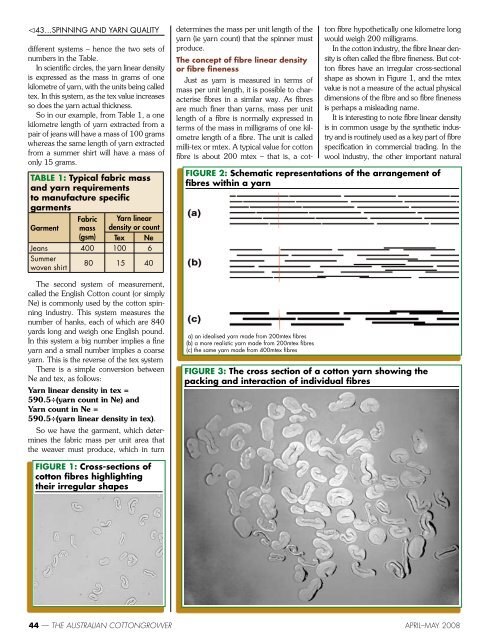The importance of fibre fineness to spinning and yarn quality
The importance of fibre fineness to spinning and yarn quality
The importance of fibre fineness to spinning and yarn quality
Create successful ePaper yourself
Turn your PDF publications into a flip-book with our unique Google optimized e-Paper software.
w43…SPINNING AND YARN QUALITY<br />
different systems – hence the two sets <strong>of</strong><br />
numbers in the Table.<br />
In scientific circles, the <strong>yarn</strong> linear density<br />
is expressed as the mass in grams <strong>of</strong> one<br />
kilometre <strong>of</strong> <strong>yarn</strong>, with the units being called<br />
tex. In this system, as the tex value increases<br />
so does the <strong>yarn</strong> actual thickness.<br />
So in our example, from Table 1, a one<br />
kilometre length <strong>of</strong> <strong>yarn</strong> extracted from a<br />
pair <strong>of</strong> jeans will have a mass <strong>of</strong> 100 grams<br />
whereas the same length <strong>of</strong> <strong>yarn</strong> extracted<br />
from a summer shirt will have a mass <strong>of</strong><br />
only 15 grams.<br />
Table 1: Typical fabric mass<br />
<strong>and</strong> <strong>yarn</strong> requirements<br />
<strong>to</strong> manufacture specific<br />
garments<br />
Garment<br />
Fabric<br />
mass<br />
(gsm)<br />
Yarn linear<br />
density or count<br />
Tex Ne<br />
Jeans 400 100 6<br />
Summer<br />
woven shirt<br />
80 15 40<br />
<strong>The</strong> second system <strong>of</strong> measurement,<br />
called the English Cot<strong>to</strong>n count (or simply<br />
Ne) is commonly used by the cot<strong>to</strong>n <strong>spinning</strong><br />
industry. This system measures the<br />
number <strong>of</strong> hanks, each <strong>of</strong> which are 840<br />
yards long <strong>and</strong> weigh one English pound.<br />
In this system a big number implies a fine<br />
<strong>yarn</strong> <strong>and</strong> a small number implies a coarse<br />
<strong>yarn</strong>. This is the reverse <strong>of</strong> the tex system<br />
<strong>The</strong>re is a simple conversion between<br />
Ne <strong>and</strong> tex, as follows:<br />
Yarn linear density in tex =<br />
590.5÷(<strong>yarn</strong> count in Ne) <strong>and</strong><br />
Yarn count in Ne =<br />
590.5÷(<strong>yarn</strong> linear density in tex).<br />
So we have the garment, which determines<br />
the fabric mass per unit area that<br />
the weaver must produce, which in turn<br />
determines the mass per unit length <strong>of</strong> the<br />
<strong>yarn</strong> (ie <strong>yarn</strong> count) that the spinner must<br />
produce.<br />
<strong>The</strong> concept <strong>of</strong> <strong>fibre</strong> linear density<br />
or <strong>fibre</strong> <strong>fineness</strong><br />
Just as <strong>yarn</strong> is measured in terms <strong>of</strong><br />
mass per unit length, it is possible <strong>to</strong> characterise<br />
<strong>fibre</strong>s in a similar way. As <strong>fibre</strong>s<br />
are much finer than <strong>yarn</strong>s, mass per unit<br />
length <strong>of</strong> a <strong>fibre</strong> is normally expressed in<br />
terms <strong>of</strong> the mass in milligrams <strong>of</strong> one kilometre<br />
length <strong>of</strong> a <strong>fibre</strong>. <strong>The</strong> unit is called<br />
milli-tex or mtex. A typical value for cot<strong>to</strong>n<br />
<strong>fibre</strong> is about 200 mtex – that is, a cot<strong>to</strong>n<br />
<strong>fibre</strong> hypothetically one kilometre long<br />
would weigh 200 milligrams.<br />
In the cot<strong>to</strong>n industry, the <strong>fibre</strong> linear density<br />
is <strong>of</strong>ten called the <strong>fibre</strong> <strong>fineness</strong>. But cot<strong>to</strong>n<br />
<strong>fibre</strong>s have an irregular cross-sectional<br />
shape as shown in Figure 1, <strong>and</strong> the mtex<br />
value is not a measure <strong>of</strong> the actual physical<br />
dimensions <strong>of</strong> the <strong>fibre</strong> <strong>and</strong> so <strong>fibre</strong> <strong>fineness</strong><br />
is perhaps a misleading name.<br />
It is interesting <strong>to</strong> note <strong>fibre</strong> linear density<br />
is in common usage by the synthetic industry<br />
<strong>and</strong> is routinely used as a key part <strong>of</strong> <strong>fibre</strong><br />
specification in commercial trading. In the<br />
wool industry, the other important natural<br />
Figure 2: Schematic representations <strong>of</strong> the arrangement <strong>of</strong><br />
<strong>fibre</strong>s within a <strong>yarn</strong><br />
a) an idealised <strong>yarn</strong> made from 200mtex <strong>fibre</strong>s<br />
(b) a more realistic <strong>yarn</strong> made from 200mtex <strong>fibre</strong>s<br />
(c) the same <strong>yarn</strong> made from 400mtex <strong>fibre</strong>s<br />
Figure 3: <strong>The</strong> cross section <strong>of</strong> a cot<strong>to</strong>n <strong>yarn</strong> showing the<br />
packing <strong>and</strong> interaction <strong>of</strong> individual <strong>fibre</strong>s<br />
Figure 1: Cross-sections <strong>of</strong><br />
cot<strong>to</strong>n <strong>fibre</strong>s highlighting<br />
their irregular shapes<br />
44 — THE AUSTRALIAN COTTONGROWER APRIL–MAY 2008
















